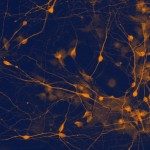Lien vers Pubmed [PMID] – 14512833
Neuroreport 2003 Sep;14(13):1655-63
The perception of odorant molecules provides the essential information that allows animals to explore their surrounding. We describe here how the external world of scents may sculpt the activity of the first central relay of the olfactory system, i.e., the olfactory bulb. This structure is one of the few brain areas to continuously replace one of its neuronal populations: the local GABAergic interneurons. How the newly generated neurons integrate into a pre-existing neural network and how basic olfactory functions are maintained when a large percentage of neurons are subjected to continuous renewal, are important questions that have recently received new insights. Furthermore, we shall see how the adult neurogenesis is specifically subjected to experience-dependent modulation. In particular, we shall describe the sensitivity of the bulbar neurogenesis to the activity level of sensory inputs from the olfactory epithelium and, in turn, how this neurogenesis may adjust the neural network functioning to optimize odor information processing. Finally, we shall discuss the behavioral consequences of the bulbar neurogenesis and how it may be appropriate for the sense of smell. By maintaining a constitutive turnover of bulbar interneurons subjected to modulation by environmental cues, we propose that adult ongoing neurogenesis in the olfactory bulb is associated with improved olfactory memory. These recent findings not only provide new fuel for the molecular and cellular bases of sensory perception but should also shed light onto cellular bases of learning and memory.

